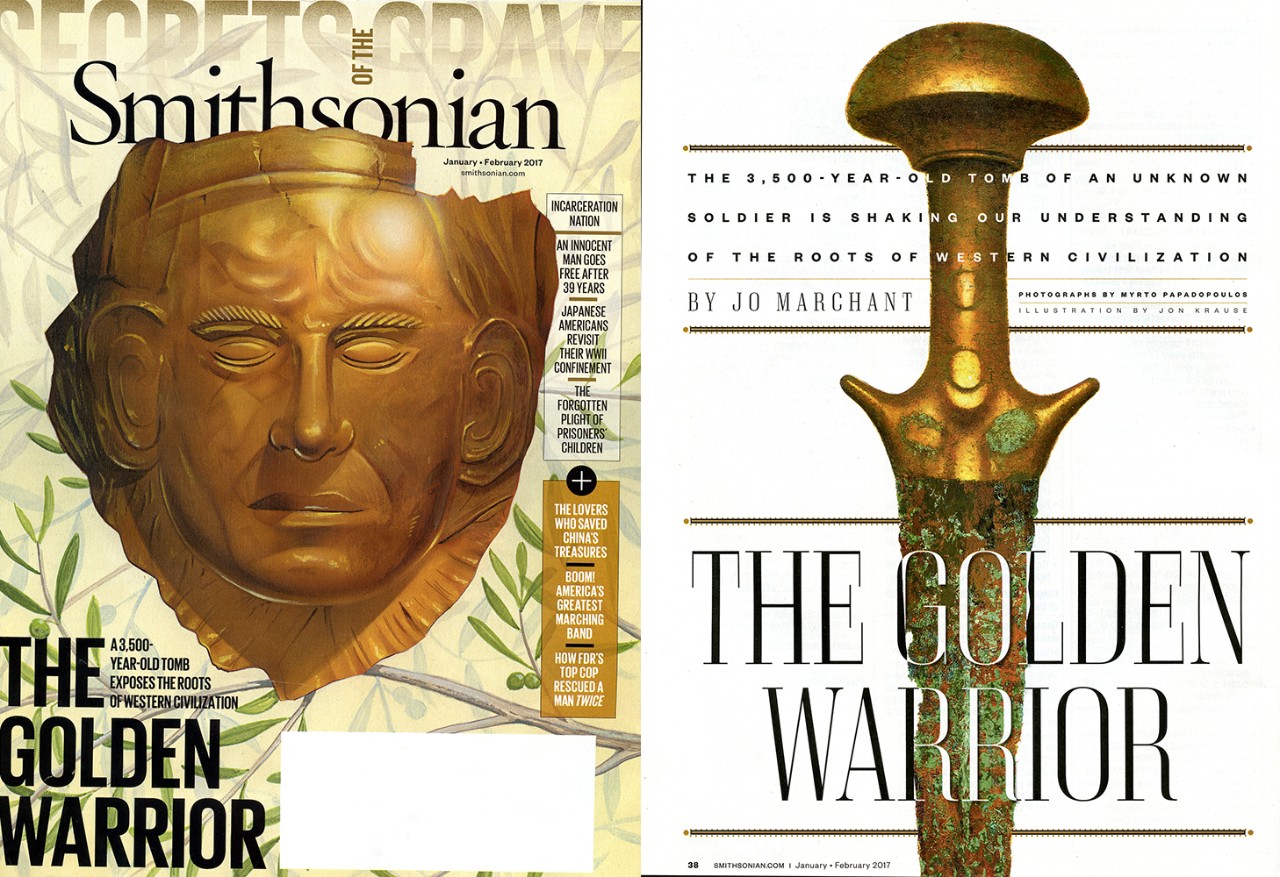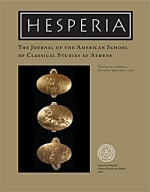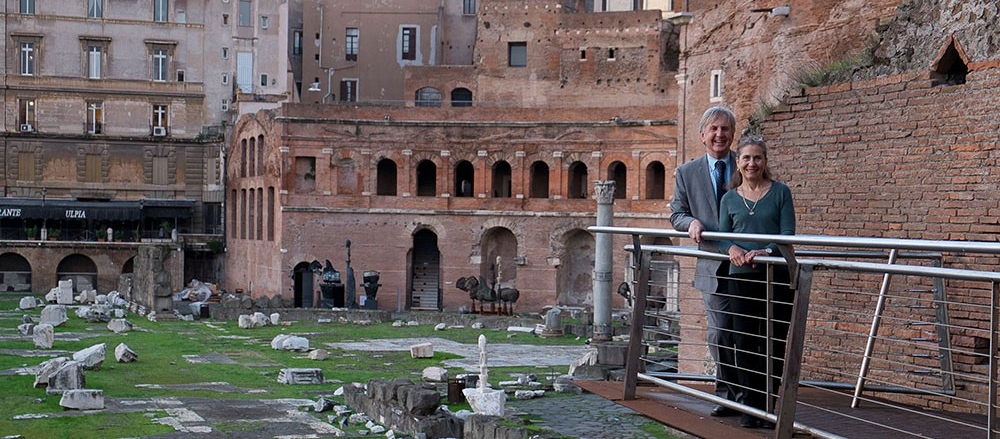Secrets of the Griffin Warrior
Two years after a team of University of Cincinnati archaeologists uncovered the Griffin Warrior’s tomb, new revelations gleaned from the ancient warrior-priest’s treasure-laden grave continue to emerge. What they tell researchers could re-write ancient Greek history.
by Rachel Richardson
513-556-5219
Jan. 6, 2017
When University of Cincinnati researchers uncovered the 3,500-year-old tomb of a Bronze Age Warrior in southwest Greece in 2015, they unearthed far more than an incredible trove of priceless gold and silver cups, precious jewelry, bronze weapons and armor and other riches.
The discovery, hailed by experts as “the find of a lifetime,” represents a time capsule preserving not only the details of the life of what is believed to have been a powerful Mycenaean warrior or priest, but of an era of ancient Greek civilization still steeped in mystery.
Dead men do tell tales. And what the tomb of the so-called “Griffin Warrior” tells scholars may unlock the mysteries of the roots of Western civilization.
Sharon Stocker, a senior research associate in UC's Department of Classics, and Jack Davis, the university's Carl W. Blegen chair in Greek archaeology, continue to reveal new revelations from artifacts discovered in the tomb, including important insights gleaned from four Minoan-style gold signet rings that are on their own a hugely significant find for scholars.

Latest revelations from tomb artifacts
Stocker and Davis detail their astonishing archaeological discovery in the cover story of the January/February 2017 edition of Smithsonian magazine, a national publication with a circulation of more than 2 million.
The very first organized Greek society belonged to the Mycenaeans, whose kingdoms exploded out of nowhere on the Greek mainland around 1600 B.C. Although they disappeared equally dramatically a few hundred years later, giving way to several centuries known as the Greek Dark Ages, before the rise of “classical” Greece, the Mycenaeans sowed the seeds of our common traditions, including art and architecture, language, philosophy and literature, even democracy and religion. “This was a crucial time in the development of what would become Western civilization,” Stocker says.
Yet remarkably little is known of the beginnings of Mycenaean culture. The Pylos grave, with its wealth of undisturbed burial objects and, at its bottom, a largely intact skeleton, offers a nearly unprecedented window into this time—and what it reveals is calling into question our most basic ideas about the roots of Western civilization.

“Lord of the Gold Rings: The Griffin Warrior of Pylos,” published in the October-December edition of Hesperia: The Journal of the American School of Classical Studies at Athens. Read online or download a PDF via JStor.
The first academic article on the unlooted grave of the Griffin Warrior focuses on the four gold signet rings found with the warrior. Davis and Stocker present the excavation of the grave, its finds, and the warrior himself, providing context for the rings. Then they describe the rings themselves and the religious scenes they depict. The significance of the rings’ iconography is also discussed, with special consideration given to the possible relationships between the items shown on the rings and the objects found within the grave.

The impact of the latest discoveries has been noted by global media coverage, including news written in Greek, Russian and Arabic. A few of the more prominent mentions include:
- The New York Times - Grave of ‘Griffin Warrior’ at Pylos Could Be a Gateway to Civilizations
- Smithsonian Magazine - The Incredible Treasures Found Inside the 'Griffin Warrior' Tomb
- National Geographic - Rare Unlooted Grave of Wealthy Warrior Uncovered in Greece
For a more complete list of publications, please visit griffinwarrior.org/griffinwarrior-publicity.html
Lectures & Events
- Learn more about the "Griffin Warrior at Pylos" during a free lecture on Wednesday, Jan. 18, hosted by the Taft Research Center. Stocker and Davis will speak at the event, set at 4:30 p.m. at the center in Edwards One, ste. 1100, on the University of Cincinnati campus.
Directions to campus are available here. For more information, call 513-556-0675.
- Stocker and Davis presented “The Palace of Nestor at Pylos, 2015–2016” at the annual meeting of the Archaeological Institute of America and the Society for Classical Studies on Friday, Jan. 6. The conference, held in Toronto, explored advances in archaeology in Europe, the Mediterranean, western Asia and beyond.
- The researchers described the spectacular weapons, ivory combs, seal stones, and Minoan-style gold rings discovered in the Griffin Warrior tomb at a series of lectures in the fall of 2016:
- Oct. 6: “Lord of the Gold Rings: The Grave of the Griffin Warrior of Pylos,” The American School of Classical Studies at Athens, Greece
- Oct. 11: “All the glitters is gold: The Grave of the Griffin Warrior at Pylos,” The Hellenic Centre, London
- Nov. 6: “A Prince of Pylos: The Tomb of the Griffin Warrior,” J. Paul Getty Museum, Los Angeles
- Nov. 17: “From the Silent Earth: The Griffin Warrior of Pylos,” Rainey Auditorium, Penn Museum, Philadelphia
- Nov. 18: “A Prince of Pylos: The Tom of the Griffin Warrior,” NYU, The Institute of Fine Arts, New York
Awards & honors
The Premio Internazionale Giuseppe Sciacca awarded Stocker and Davis its International Guiseppe Sciacca Award at the Pontifical Urban University in Vatican City Nov. 12.
The prestigious Vatican-sponsored award recognizes those who have made significant contributions in their field and who have embraced the principles of friendship and collaboration among all peoples and nations.
Watch: Ceremonia di Premiazione Sciacca 2016 (Stocker and Davis segment begins at 56.27)

About the “Griffin Warrior”
In the spring of 2016, a UC-based team made a rich and rare discovery of an intact, Bronze Age warrior’s tomb dating back to about 1500 B.C. in the Pylos region of Greece. The Greek Culture Ministry declared the find the “most important to have been discovered [in continental Greece] in 65 years” by the Greek Culture Ministry. The tomb revealed a remarkably intact skeleton, which UC researchers dubbed the “Griffin Warrior” for the discovery of an ivory plaque adorned with a griffin — a mythical beast with the body of a lion and the head and wings of an eagle — buried with him. The 3,500-year-old shaft grave also revealed more than 2,000 objects arrayed on and around the warrior’s body, including four solid gold rings, silver cups, precious stone beads, fine-toothed ivory combs and an intricately built sword, among other weapons.
Read more about the Griffin Warrior tomb at UC Magazine:
- UC team discovers rare warrior tomb filled with bronze age wealth and weapons
- Lord of the rings: UC team’s discovery prompts new consideration of Greek history
Additional information is available at www.griffinwarrior.org
About Classics at the University of Cincinnati College of Arts and Sciences
For 75 years, the Department of Classics of the University of Cincinnati College of Arts and Sciences has organized and supported archaeological research projects in the Mediterranean. This commitment to sustained archaeological research is paralleled by few other academic institutions in the United States. A consistent program of excavations and surveys has built the department's well-deserved reputation as one of the world’s preeminent centers of graduate education in pre-Classical and Classical archaeology.

